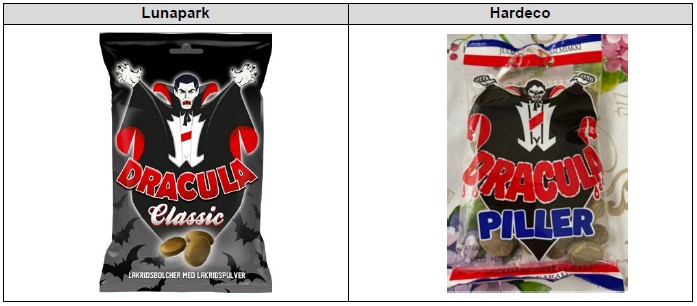CJEU Ruling Denies Forfeiture of Trade Mark Rights through Inactivity and Underscores the Importance of Timely Trade Mark Registration
22 Aug 2025 | Newsletter
In a judgment of 1 August 2025 in the case of Lunapark Scandinavia Oy Ltd vs. Hardeco Finland Oy (C-452/24), the Court of Justice of the European Union (CJEU) clarified the scope of national procedural autonomy in the enforcement of intellectual property rights. The judgment confirms that national rules must not undermine the objective pursued by the EU Trade Mark Directive in ensuring uniform protection for registered trade marks across all EU Member States, and underscores the importance of timely trade mark registration.
Facts and background
A dispute arose in Finland between Lunapark Scandinavia Oy Ltd (Lunapark), which holds the Finnish trade mark “DRACULA” (word) for confectionery products, and Hardeco Finland Oy (Hardeco). The “DRACULA” trade mark was registered in 2009. Prior to this registration, another company, Karkkimies Oy, had been importing sweets under the name “Dracula” without associated trade mark rights. In 2019, Hardeco acquired Karkkimies and continued selling similar products with packaging displaying the word “Dracula” and images representing the character.

Lunapark filed a lawsuit against Hardeco in October 2020 for alleged infringement, seeking an injunction and damages. Hardeco responded by asserting that Lunapark’s prolonged inactivity and failure to take action against Karkkimies constituted a forfeiture of its right to enforce the trademark. The Finnish Market Court (Markkinaoikeus) held that the signs in question were identical and likely to result in confusion, but rejected Lunapark’s claim on the grounds of unreasonable delay in taking action. The court invoked a well-established principle of Finnish private law requiring that a claimant must initiate proceedings or assert its rights within a reasonable period after becoming, or having the opportunity to become, aware of the facts underlying the claim.
Lunapark appealed this decision to the Supreme Court of Finland (Korkein oikeus), which asked the CJEU to clarify whether Article 10 of the EU Trade Mark Directive 2015/2436 (EUTMD) permits such a limitation beyond the express acquiescence provisions outlined in Articles 18 and 9 of the EUTMD.
The CJEU’s Reasoning and Ruling
The CJEU ruled decisively in favour of Lunapark, establishing several key principles. Referring to its previous decisions in SodaStream (CJEU, 27 October 2022, SodaStream, C‑197/21) and Budějovický Budvar (CJEU, 22 September 2011, Budějovický Budvar, C‑482/09), the CJEU stated that (i) Article 10 EUTMD establishes a fully harmonised framework for the rights conferred by a trade mark across the EU; (ii) Article 9 EUTMD completely harmonises the conditions under which a holder of a later registered trade mark may retain rights when challenged by the holder of an earlier identical trade mark; and (iii) Article 18(1) EUTMD fully harmonises the limitations on exclusive rights due to the holder’s inactivity, allowing acquiescence only in relation to later registered trade marks, but not unprotected signs that do not confer exclusive rights.
Since Article 9 EUTMD (applicable to proceedings seeking a declaration of invalidity) and Article 18(1) EUTMD (applicable to infringement proceedings) both relate to potential disputes between registered trade marks, established case law concerning ‘Preclusion of a declaration of invalidity due to acquiescence’ under Article 9 EUTMD equally applies to acquiescence in the context of infringement actions involving later registered trade marks under Article 18(1) EUTMD. Permitting EU Member States to implement broader national principles, such as a general “reasonable time” limitation, would undermine the objective pursued by the EUTMD in ensuring uniform protection for registered trade marks in the legal systems of all the EU Member States.
Although Karkkimies began using the “Dracula” sign prior to Lunapark’s registration of the “DRACULA” mark, neither Karkkimies nor Hardeco obtained exclusive rights to the sign, either through registration or use. Thus, in circumstances where the holder of a registered trade mark enforces his exclusive rights under Article 10 EUTMD to prevent the use of an earlier unregistered sign, the CJEU concluded that a national court may not restrict the exercise of those exclusive trade mark rights beyond what is stipulated in Article 18(1), in conjunction with Article 9 EUTMD.
Comments and Implications
The CJEU’s judgment clarifies that national principles regarding “reasonable time” cannot restrict the exclusive rights of the holder of a registered trade mark, except as outlined under the strict requirements of Articles 18 and 9 EUTMD. However, the broader implications of this ruling remain subject to interpretation.
While the CJEU’s judgment appears to prevent forfeiture of rights through inactivity, addressing the concept of ‘preclusion due to acquiescence’ (rechtsverwerking wegens gedogen/ forclusion pour tolérance – which is also not recognised as a general legal principle in Belgium), it does not explicitly consider other grounds under national law, such as abuse of rights (rechtsmisbruik/abus de droit). These may still be applicable in line with recital 40 of the EUTMD, which states that “[The] Directive should not exclude the application to trade marks of provisions of law of the Member States other than trade mark law, such as provisions relating to unfair competition, civil liability or consumer protection”. As a result, for Belgian or EU courts that already confine the concept of “rechtsverwerking” to EU-harmonised acquiescence rules, the judgment aligns with existing practice. However, for courts in EU Member States such as the Netherlands that recognise the concept of “rechtsverwerking”, this judgment may have a decisive impact.
Because of the fully harmonised framework, it is also questionable whether provisions of national (e.g. Benelux) law that do not correspond to the content of the EUTMD, such as those concerning the ‘negative reflex effect’ resulting from Article 2.19 of the Benelux Convention on Intellectual Property, are still compatible with the EUTMD.
Finally, the judgment highlights the legal implications of registering trade marks promptly. In this case, the claimant may indeed be able to prevent the use of a sign that had been present in the market for a long time without registration, relying on a trade mark registered at a later date. For trade marks holders, this judgment confirms the legal certainty provided by registration; not only to restrict unauthorised use but also to preclude the possibility of others registering and asserting exclusive rights over the same trade mark in the future. Holders of unregistered signs are reminded that long-term use does not confer the same level of protection as registration.
But even if a long delay before taking action does not deprive a trade mark holder of the ability to act, a long period of peaceful coexistence on the market may still lead to a finding that there is no likelihood of confusion. For instance, in Kerrygold (CJEU 20 July 2017, C‑93/16), the CJEU held that peaceful coexistence between an EU trade mark and a national mark is a relevant factor -although not decisive on its own and territorially bounded- in the global assessment of likelihood of confusion.


